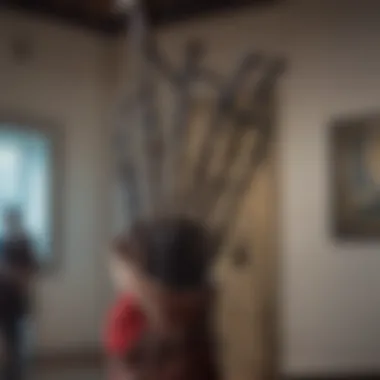Exploring the Cultural Significance of Bagpipes in Scotland


Intro
Bagpipes have long been an emblematic instrument of Scotland, resonating through the rolling hills and lively gatherings across the country. In contrast to many musical instruments that have arbitrary links to cultural identity, bagpipes carry a profound significance that speaks to Scotland's history, identity, and heritage. Their distinct sound is not merely an auditory experience but a representation of the emotional fabric and vibrant traditions of Scotland. As we delve deeper into this exploration of bagpipes, we will uncover their past, contemporary relevance, and the role they play in uniting communities and defining Scottish identity.
Artist Profile
Biography and Background
Scotland has produced numerous notable bagpipe players, each contributing to the richness of this musical tradition. One such figure is Fred Morrison, a celebrated piper known for his innovative approach. Born in 1965 in the Scottish Highlands, Morrison's early exposure to traditional Highland piping laid the groundwork for his future endeavors. His interest in various musical styles propelled him to blend traditional bagpipe melodies with modern influences, which allowed him to reach a broader audience.
Major Influences and Inspirations
A myriad of influences shapes Morrison's unique sound. His upbringing steeped in Scottish folk music played a crucial role in molding his artistic vision. Moreover, he draws inspiration from global musical genres, weaving diverse rhythms and tunes into his compositions. The melodic nature of traditional Scottish tunes serves as a canvas for Morrison's creativity. Through his work, he embodies the evolution of Scottish bagpipes, emphasizing their place in both historical and contemporary contexts.
Bagpipe Variants
The Scottish bagpipes encompass several variants, reflecting the different regions and traditions within Scotland. Some notable types include the Great Highland Bagpipe, the Border Bagpipes, and the Uilleann pipes.
- Great Highland Bagpipe: Recognized as the most iconic type, it has a powerful sound that resonates during celebrations and ceremonies.
- Border Bagpipes: A relatively softer and quieter variant, they produce a more melodious tone, often used in pastoral settings.
- Uilleann Pipes: Though primarily associated with Irish music, these pipes have found their place in the Scottish repertoire, offering a unique combination of melody and harmony.
Understanding these varieties is essential to appreciate their distinct contributions to the cultural tapestry of Scotland.
Cultural Significance
The significance of bagpipes stretches beyond music. They serve as a symbol of Scottish pride and community identity. During significant events like weddings, funerals, and military ceremonies, bagpipes invoke a deep sense of belonging and emotional connection. They are often performed at public gatherings, leading parades and ceremonies, marking important milestones in Scottish life. This connection to various aspects of social life showcases how integral bagpipes are to Scotland’s cultural framework.
"The bagpipe, with its haunting harmonies, transcends just a musical instrument, representing the very heart of Scottish culture."
Modern Representation in Music
Bagpipes are often infused into various modern genres, expanding their reach and popularity. From pop to rock, artists are beginning to embrace this age-old instrument to bring a fresh twist to their compositions. Notable musicians like The Proclaimers and The Waterboys have incorporated bagpipes into their music, blending traditional sounds with contemporary styles. This fusion demonstrates the adaptability of bagpipes, securing their place in the ever-evolving music landscape.
Culmination
In understanding bagpipes, one must appreciate the deep-rooted cultural and historical relevance they carry. As we explore various aspects of this intriguing instrument, we reveal its significance beyond simple melody. The journey through Scotland's musical heritage offers profound insights into the enduring legacy of bagpipes, their evolution, and their role in shaping collective identity.
Foreword to Bagpipes
Bagpipes hold a significant place in Scottish culture and heritage. This section serves as an introduction to the topic, delving into the essence of bagpipes and how they have come to symbolize not just music, but also a rich tapestry of Scottish identity. Understanding the bagpipe goes beyond its sound; it encompasses its construction, its history, and its role in various cultural contexts.
Definition and Structure
Bagpipes are wind instruments that produce sound through the vibration of air. The basic structure of a bagpipe includes several components: the bag, chanter, drones, and reeds.
- Bag: Materials often used range from animal skins to synthetic fibers. The bag holds air and allows for a continuous sound.
- Chanter: This is the melodic part of the instrument. It has finger holes that allow the musician to play different notes.
- Drones: These provide a constant pitch that supports the melody played on the chanter. Typically, there are multiple drones, each tuned to different notes.
- Reeds: Reeds are essential for producing sound in both the chanter and drones. Understanding the type of reeds is critical for sound quality.
The physical characteristics of bagpipes differ by region and style. For instance, the Great Highland Bagpipe has a more pronounced and robust sound compared to smaller varieties like the smallpipes.
Significance of Bagpipes in Scottish Culture
Bagpipes are more than just musical instruments; they are deeply intertwined with Scottish identity and tradition. They are often played at festivals, weddings, and other cultural events, serving to unite communities and evoke a sense of national pride.
The emotional weight carried by the music is profound, often stirring feelings of nostalgia and celebration concurrently. The sound of bagpipes can be heard during ceremonies, particularly in remembrance of historical events.
More than a sound, the bagpipes symbolize resilience, reflecting Scotland's tumultuous past, its struggles, and triumphs. This cultural emblem transcends generations, finding its place in modern expressions of Scottish identity.
"Bagpipes create an atmosphere that can lift spirits and connect individuals to their roots."


In summary, the introduction not only presents the bagpipes as a musical creation but recognizes their vital role in shaping Scottish culture and community. Their relevance is continually reaffirmed in contemporary society as more individuals engage with this emblematic instrument.
Historical Origins of Bagpipes
Understanding the historical origins of bagpipes is essential when examining their role in Scottish culture. These instruments have been woven into the fabric of the nation’s identity for centuries. Their evolution reflects not only musical trends but also social dynamics and cultural influences. Tracing these origins sheds light on how bagpipes have become a symbol of Scottish heritage while highlighting the changes in musical expression over time.
Early Evidence of Bagpipes
The first recorded instances of bagpipes date back several centuries, with evidence suggesting their presence in different parts of the world. For Scotland, the earliest documents reference the instrument around the 14th century. Bagpipes likely emerged through various iterations, eventually morphing into what we recognize today as the iconic Great Highland Bagpipe. Archaeological finds, including ancient depictions and artifacts from Roman times, reveal that similar instruments were used in various cultures, suggesting widespread appeal and functionality.
One notable find was in the medieval manuscript The Lament of the Bards, which describes musicians playing bagpipes at gatherings and ceremonies. This points to the instrument’s significance in both entertainment and commemoration during crucial life events.
Migration and Evolution of Styles
As people migrated and cultures mingled, the styles of bagpipes also transformed. The influence of various European musical traditions contributed to the unique characteristics of Scottish bagpipes. Instruments such as the Irish Uilleann pipes and the Northumbrian smallpipes show a direct lineage to the early forms of bagpipes.
Scottish bagpipes, in particular, evolved in distinct ways. The Great Highland Bagpipe became the most recognized type. Its strong, rich tones have been associated with military and ceremonial uses, but it has also been adapted for modern music genres. Similarly, smallpipes and Border pipes, instruments with quieter tones, fit into different musical contexts and styles.
Important migrations, especially in the 17th and 18th centuries, facilitated the exchange of musical ideas. Traveling musicians often took their traditions to new regions. This led to hybridization and expanded the global footprint of bagpipe music. The changes in styles reflect not merely aesthetic choices but also the cultural dialogues surrounding identity, power, and community.
"The history of bagpipes is a reflection of human connection, migration, and cultural dialogue across ages and continents."
By analyzing these historical elements, we gain insight into how bagpipes have secured their place in the hearts and minds of Scottish people. Their journey from historical origins to modern adaptations illustrates an ongoing evolution that honors tradition while embracing change.
Types of Scottish Bagpipes
The exploration of Scottish bagpipes unveils a diversity that is essential for understanding their cultural significance. Each type of bagpipe contributes uniquely to the rich tapestry of Scottish music, providing insight into regional variations and playing styles. By examining these differences, one can appreciate how each type reflects not only musical but also historical and social aspects of Scottish life. Therefore, recognizing the distinct characteristics of each type is vital for anyone interested in the traditions and evolution of Scottish music.
Great Highland Bagpipe
The Great Highland Bagpipe is perhaps the most recognized among all Scottish bagpipes. Traditionally, it has been associated with Highland culture and often features prominently in both military and social settings. Its powerful, resonant sound can be attributed to its three drones and a chanter, which allows for a commanding auditory presence. The instrument is known for its elegant embellishments and intricate finger work, making it a favorite among skilled players.
Historically, the Great Highland Bagpipe served a variety of roles, from communicating signals in battle to providing music for ceremonies. Its prominence in military bands during the 19th century helped solidify its status as a symbol of Scottish identity. The strength and depth of sound resonate with both pride and longing, enhancing any cultural event.
Smallpipes
In contrast to the robust Great Highland Bagpipe, the Smallpipes offer a softer and mellower tone. These chanters are usually played with a less aggressive blowing technique, allowing for a more intimate and quiet musical experience. The Smallpipes have a range of tonal qualities that make them suitable for indoor performances and small gatherings.
The structure of Smallpipes includes one or more drones and a single chanter, differing from the more pronounced drones of the Great Highland Bagpipe. This type of bagpipe is often appreciated for its versatility and adaptability across various musical genres, from traditional folk to contemporary acoustic performances. Musicians who favor Smallpipes often value the intricate melodies that can be produced, fostering a deeper connection with the audience.
Border Pipes
The Border Pipes represent a unique segment of Scottish piped music, originating from the borders between Scotland and England. Characterized by a more relaxed playing style and a distinct drone configuration, they produce a sound that is less overpowering than the Great Highland Bagpipe but still rich in texture. A prominent feature of Border Pipes is their use of a flat chanter, which produces a different range of notes.
These bagpipes often blend the influences of Scottish and English musical traditions, enriching the cultural exchange of the region. Border Pipes have gained popularity particularly in traditional Scottish dance music, where their sound complements the lively atmosphere. As a result, they are essential to understanding regional differences in piping styles and contribute to the overall diversity of Scottish music.
"Each type of Scottish bagpipe tells a story, reflecting the history and culture from which it originates."
In summary, the types of Scottish bagpipes offer a glimpse into the varied musical landscape of Scotland. The Great Highland Bagpipe, Smallpipes, and Border Pipes each embody distinct traditions and styles, enhancing the overall appreciation of this pivotal aspect of Scottish culture.
Famous Bagpipe Players
Understanding the contributions of famous bagpipe players offers significant insight into the cultural fabric of Scotland. These musicians have not only preserved traditional styles but have also innovated and adapted their craft, influencing generations of players. By examining both historical figures and contemporary influencers, we grasp how these musicians shape the public perception of bagpipes and contribute to cultural pride.
Notable Historical Figures
Historically, bagpipe music has been propelled by iconic figures who have shaped its narrative. One such figure is Donald Maclean of Lewis, recognized for his profound impact on the musical landscape in the 20th century. His innovative techniques and style have inspired countless pipers to this day, establishing a benchmark for excellence.
Another significant name is Pipe Major John MacLellan, a distinguished player and composer known for his contributions to the Scottish regimental music tradition. His works remain a staple in competitions and performances, emphasizing the connection between the military and traditional Scottish music. The legacies of these players illustrate how individual artistry can influence the collective understanding of bagpipe music.


In addition to Maclean and MacLellan, figures like William Lawrie contributed to furthering the popularity of bagpipes through their grassroots teaching and performances. These players helped lay the groundwork for today’s vibrant bagpipe culture.
Contemporary Influencers
In modern times, bagpipe music continues to evolve through contemporary influencers. Bruce Gandy, a prominent figure in the current scene, is known for his blend of traditional and modern techniques that attract a diverse audience. His ability to bridge different music genres ensures that the bagpipe reaches new listeners.
Another noteworthy player is Roderick Morison, who employs innovative arrangements in both solo performances and collaboration projects. His work challenges traditional norms while honoring the instrument's rich past.
These contemporary figures show that bagpipes remain relevant today. Through their adaptation and creativity, they draw a younger audience, ensuring that bagpipe music continues to thrive in modern contexts. Their influence encourages budding musicians to explore the versatility of this unique instrument.
"The bagpipe is not just an instrument; it is a voice of our culture and a symbol of heritage that continues to inspire musicians around the world."
Bagpipes in Scottish Festivals
The presence of bagpipes in Scottish festivals is indispensable. These events have become cultural landmarks, celebrating not only the music but also the traditions that define Scottish identity. The melodies produced by bagpipes have a unique ability to evoke emotions and connect with people across generations. Festivals serve as a platform where bagpipe music can thrive, showcasing its importance in Scotland's cultural heritage.
Highland Games
Highland Games are among the most iconic festivals in Scotland, deeply intertwined with the celebration of Scottish culture. Traditionally held in the summer months, these games are not just a competition of strength but also a rich showcase of Scottish arts, crafts, and music. Bagpipe performances are central to the atmosphere of these events. The music, resonating through the fields, enhances the pride and spirit of competition among athletes.
The involvement of bagpipes at Highland Games can be seen in various formats. Pipe bands perform tirelessly, marching in coordinated formations. Competitors often enter the arena accompanied by the powerful sounds of them. The unique style of the Great Highland Bagpipe adds prestige, marking the opening ceremonies and various events throughout the day.
Additionally, the competitions among pipers themselves create a lively environment, fostering a sense of camaraderie. Participants are judged not only on technical skill but also on their interpretive abilities, adding a layer of artistry to the competition. This blend of athleticism and music makes Highland Games a celebration of what it means to be Scottish.
Pipe Band Competitions
Pipe band competitions are dedicated events focusing entirely on the skill and artistry of bagpipe playing. These competitions attract musicians from across the globe, eager to showcase their talent and honor the traditional styles of piping. The competitions vary in level, from local bands to world-renowned school, fostering growth and learning within the community.
During these competitions, bands are judged in several categories. These include the overall sound, precision, and creativity of their performances. The tension in the air as bands await the results is palpable. Each note played is a display of the hard work and passion put into their craft. For aspiring musicians, these events offer insight into the intricacies of performing in a pipe band setting, and many use these experiences to hone their own skills.
The historical context of bagpipes in Scottish festivals cannot be ignored. These events are not just about competition; they solidify the role of bagpipes as a cultural symbol. The music played resonates with the themes of pride and heritage, reminding all present of the rich tapestry of Scottish history. Therefore, bagpipes remain a vital and cherished part of Scottish festivals today.
Cultural Symbolism of Bagpipes
The bagpipes stand as a potent emblem of Scottish culture, infusing its art, music, and identity with a rich tapestry of historical and emotional significance. Understanding this cultural symbolism is essential, as it transcends simple musicality to embody national pride and a deep-rooted heritage that resonates with Scottish people. The bagpipes are often regarded not just as an instrument, but as a narrative that weaves through the tapestry of Scotland’s past and present.
National Identity and Heritage
Bagpipes are deeply entwined with the national identity of Scotland. When played, they evoke a sense of belonging and cultural pride among Scots. Historically, the instrument has served various roles; it played during battles and celebrations, making it a vital component of societal fabric. The sound of the Great Highland Bagpipe can signify both joyous and somber occasions, showcasing its versatility in marking moments of important significance in Scottish life.
The emotional connection Scots have with the bagpipes is profound. For many, the instrument is a symbol of resilience and unity, reflecting the spirit of communities that have historically faced challenges. Events like the Highland Games often feature pipers, reinforcing the association of bagpipes with Scottish sporting culture, and it’s at these gatherings that one can truly feel the weight of this heritage. The tradition of piping is passed down through generations, ensuring that younger Scots grow up with a sense of their cultural roots.
Here are some key factors that highlight the symbolic relevance of bagpipes to national identity:
- Resilience: The bagpipes have survived numerous political and social changes, becoming a symbol of perseverance.
- Unity: The sound of the bagpipes often rallies people together, fostering a sense of community.
- Heritage: Many Scots take pride in the craftsmanship and skill involved in playing the instrument, linking it to their ancestry.
Bagpipes in Scottish Literature and Art
Apart from their musical significance, bagpipes have also found their way into various forms of Scottish literature and art. They are frequently referenced in poetry and prose, often symbolizing the beauty of the Scottish landscape and the complexity of its culture. The bagpipe often acts as a motif to evoke nostalgia, longing, and a connection to the land.
Artists and authors have depicted bagpipes not merely as instruments but as vessels carrying the stories of the Scottish people. Their presence in literature can signify a range of emotions from joy to sorrow, encapsulating the duality of the Scottish experience. For example, works of poets like Robert Burns often infused their lines with references to bagpipes, linking music with themes of love, longing, and patriotism.
Moreover, in the realm of visual arts, the image of a piper often symbolizes celebration and cultural events, becoming a prominent feature in paintings that illustrate Scottish life. This visual representation further solidifies the place of bagpipes within the broader narrative of Scottish identity.
"In the echoes of the bagpipes, one hears the heartbeat of Scotland itself."
Through these representations in literature and art, bagpipes emerge as cultural symbols that articulate the emotional landscape of Scotland. They illustrate the dynamic interplay between music, identity, and heritage, making them indispensable to understanding Scottish culture in a more profound way.


Modern Adaptations of Bagpipes
The landscape of music is consistently evolving, and the bagpipe is no exception. In recent decades, the adaptation of bagpipes into various modern contexts has become increasingly evident. This transformation plays a crucial role in maintaining relevance and innovation within a rich tradition.
Fusion with Other Music Genres
One of the most notable developments in the world of bagpipes is their fusion with other musical genres. Bagpipes are no longer confined to traditional Scottish folk music. Instead, they find themselves blending seamlessly into rock, jazz, and even electronic music. Artists like Rhuaridh McMillan and Duncan Chisholm have collaborated with musicians from different backgrounds to produce unique soundscapes.
The blending of styles not only introduces the bagpipe to wider audiences, but also showcases its versatility. For instance, the incorporation of electronic beats creates an intriguing contrast with the robust sound of the bagpipe. This fusion encourages exploration and adapts bagpipe music to contemporary tastes, thus appealing to a broader demographic.
Bagpipes in Popular Culture
The representation of bagpipes in popular culture has also evolved. Movies, television shows, and advertisements have increasingly featured the instrument as a vital component of Scottish symbolism. Iconic films like Braveheart and The Last Legion have effectively utilized bagpipe music to evoke strong emotions and reinforce national identity.
In the realm of social media, videos demonstrating bagpipes have gained traction on platforms like Facebook and Reddit. Musicians showcase their skills, garnering attention and following from diverse audiences. These platforms give a voice to emerging talents and create communities focused on bagpipe appreciation.
Moreover, bagpipes are not just a symbol of tradition; they are also a part of the contemporary experience in music festivals and events. Collaborative performances with popular bands have led to a new generation embracing the bagpipe, breaking barriers between genres.
"The revival of bagpipes in modern music demonstrates its adaptability and potential to connect diverse audiences."
In sum, the modern adaptations of bagpipes represent a significant shift in how this historic instrument is perceived and used. The fusion with other music genres allows for creativity, while its presence in popular culture ensures its survival and relevance. As bagpipes intertwine with modern musical landscapes, the foundation of Scottish heritage persists, meeting the needs of a new audience.
Challenges Facing Bagpipe Tradition
The tradition of bagpipes in Scotland is under various pressures in the modern world. Understanding these challenges is essential, as it provides context for the future of this cultural symbol. The decline of traditional playing styles, changes in music consumption, and shifts in public interest all contribute to the complexities surrounding bagpipes today.
Decline in Traditional Playing
One significant challenge faced by the bagpipe tradition is the decline in traditional playing. Many young musicians are not exposed to the intricate techniques of historical styles. The allure of contemporary genres often overshadows traditional forms, leading to fewer individuals taking up the Great Highland Bagpipe, Smallpipes, or Border Pipes.
This decline has several causes:
- Educational Factors: Music education often emphasizes popular music forms. Traditional instruction may not be as widely available.
- Cultural Shift: As society evolves, interests in various music genres may diminish the appreciation for traditional instruments.
- Accessibility: Learning and mastering bagpipes can be challenging. This might deter potential players who opt for simpler instruments.
As a result, many authentic styles risk fading away, losing not only the music but also the stories and historical context they carry.
Preservation Efforts
Efforts to preserve the bagpipe tradition are vital for its survival. Some key initiatives focus on education, community engagement, and artistic collaboration. There are various efforts underway to ensure that this cultural artifact continues to thrive:
- Educational Programs: Schools and music academies are beginning to recognize the importance of including bagpipe instruction within their curricula. Programs may involve workshops and local competitions.
- Cultural Organizations: Groups like the Royal Scottish Pipe Band Association work to promote competitions and events that spotlight traditional playing.
- Recording Projects: Documenting traditional bagpipe music helps in keeping the culture alive. Many artists now push for a fusion of styles, blending traditional and modern influences.
"Preservation is not just about keeping the past alive; it is about ensuring a vibrant future for our cultural expressions."
The combination of these efforts represents a collective recognition that traditional bagpipe playing is more than music. It is a significant thread in the fabric of Scottish heritage.
Keeping the tradition alive demands dedication from both audiences and practitioners. As they engage in these efforts, they ensure that the meaning and sound of bagpipes continue to resonate through the ages.
Finale
The exploration of bagpipes in Scotland reveals their extensive role in both cultural heritage and identity. In a complex blend of history and artistry, this instrument transcends mere musical classification. Instead, it stands as a powerful symbol deeply rooted in the Scottish tradition. Understanding its significance can enhance appreciation for the cultures that continue to embrace its sound.
This article provides valuable insights into various aspects of bagpipes, including their historical origins, types, notable musicians, and adaptations. All these elements coalesce to paint a thorough picture of what bagpipes represent—an intrinsic part of Scottish culture.
Summary of Key Points
- Historical Origins: The bagpipe's journey begins in ancient times, evolving through migrations and cultural exchanges.
- Types of Bagpipes: The Great Highland Bagpipe, Smallpipes, and Border Pipes present varied sounds and playing styles, contributing to the rich tapestry of Scottish music.
- Famous Players: Both historical figures and contemporary stars have shaped public perception and promotion of this instrument, ensuring its place in the present.
- Cultural Symbolism: Beyond music, bagpipes symbolize national identity and resilience, often featured in literature and art that reflect societal values.
- Modern Adaptations: The fusion of bagpipes with other genres showcases its versatility, ensuring relevance in today’s musical landscape.
- Challenges and Preservation: Acknowledging decline in traditional playing, efforts to preserve and promote bagpipes become critical to sustaining this heritage.
Future of Bagpipes in Scottish Culture
The future of bagpipes in Scottish culture looks promising, despite the challenges.
- Teaching and Community Engagement: Educational initiatives play a pivotal role. Music schools and community groups seek to involve younger generations in learning to play bagpipes. Workshops and practice groups can improve accessibility.
- Cross-Genre Collaborations: The blending of styles, such as rock, jazz, and electronic music, can introduce the instrument to broader audiences. This adaptation may help maintain interest among younger musicians and listeners.
- Technological Integration: The use of digital platforms in sharing performances and tutorials can encourage participation from those who may not have access to traditional education avenues.
- Global Cultural Exchange: As global interest in Scottish culture persists, bagpipes could be integrated into international music scenes, promoting diversity and collaboration.
The instrument will likely remain a significant element of cultural expression in Scotland, fostering connections and celebrating history. By maintaining traditions while embracing modernity, bagpipes can continue to resonate through generations.







